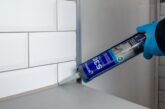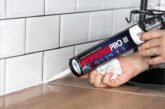
Nick Bratt, National Sales Manager, BM and DIY at Saint-Gobain Abrasives, explores how contractors can prepare for winter repair jobs using adhesive and sealant tools.
The combination of low temperatures, moisture and freezing conditions brings the likes of cracks, rust, leaks and heat loss into buildings, and even causes standard tools and materials to become less effective. Proactive maintenance and prompt repairs using suitable adhesives and sealants are essential in mitigating these issues, enhancing energy efficiency and ensuring a safe and comfortable environment for occupants.

Choose winter-ready products
When it comes to winter repairs, selecting the right products designed for cold-weather applications is paramount. Construction sealants are designed for use between 20ºC and 25ºC for optimum application. Below 5ºC, they become thicker and more challenging to apply, potentially leading to poor sealing and performance. Water-based caulks are particularly affected.
Products with low-temperature ratings and rapid curing capabilities are ideal for maintaining productivity during colder months, with some products withstanding temperatures as low as -30ºC once cured.
It’s essential for contractors to work with trusted and reputable brands like OneBond to source winter-ready products for superior performance even in adverse weather conditions.
Some must-haves we would recommend this winter are:
- Universal acrylics – assembling joinery and sealing cracks and joints to help eliminate drafts, e.g. on stairs, floorboards, windows and door frames. Not suitable for applications exposed to the elements.
- Polyurethane sealants (PU sealants) – filling expansion joints and sealing joints in various applications, e.g. concrete structures, guttering, metal roofs, cladding and brickwork. Laying roof tiles, assembling door/window framing components and sealing the perimeter. Not the best regarding UV resistance, but great when dealing with expansion and contraction, and can even be painted when cured. Best for maintaining elasticity and withstanding weathering and ageing.
- Hybrids – Easy to use and offers many benefits like better UV resistance. Fills joints and leaks, seals windows and heating ducts, mounts gutters, and frames joints and panels. For use on stone, concrete, wood, steel, aluminium, tiles and plastics. Can be painted and provide robust bonding capabilities once cured – certain variants capable of withstanding up to 300kg/m2. Can also be applied underwater – great for jobs where water is present.
- Silicones – offers excellent UV, temperature and humidity resistance and can be used for sealing window and door frames. Once cured, silicones cannot be painted, so matching the colour of the sealant and application material is vital – white, grey and transparent are the most popular. Some silicones can be specifically for indoor or outdoor use – check packaging for information.
- Epoxy putty – a great solution to keep in the toolbox for emergency repairs. These two-part putties are moulded by hand and used to repair tanks, pipes and castings, welds and non-structural defects. Can be applied underwater and used to fill oversized bolt holes. Offers excellent resistance to weathering and cold temperatures. Suits various materials, including plastics, metals, wood, ceramics, concrete and stone.
Storage and handling
Contractors must prioritise appropriate storage and handling practices to ensure any adhesive and sealants remain effective. Cold temperatures can negatively impact a product’s shelf life and consistency, potentially rendering them unusable and incurring extra costs for replacements.

Storing adhesives and sealants in temperature-controlled environments before allowing products to reach the recommended temperature range for use will ensure optimal performance. Refer to the manufacturer’s safety and technical datasheet for storage and application details.
Working with adhesives and sealants requires skill and knowledge. Before embarking on winter repair projects, contractors should ensure their workforce receives comprehensive training on handling, applying and curing products in cold weather environments.
Proper safety measures should also be strictly followed, including using PPE and implementing protocols to avoid accidents and injuries. Manufacturers like OneBond work to ensure that the raw materials in adhesives and sealants are compounded in a safe environment; however, once formulated, it’s the user’s responsibility to safely handle and dispose of these products. To ensure contractors work with the safest and most user-friendly adhesives, look out for low toxicity, low VOC and low odour formulas on packaging.

Surface preparation
Before applying adhesives and sealants, surface preparation is essential – particularly in winter conditions where moisture, frost and other environmental factors can disrupt bonding. Contractors should thoroughly clean and dry surfaces where necessary to remove contaminants that may impact adhesion. Roughening or priming surfaces may further enhance the bonding strength of adhesive and sealant products, ensuring long-lasting results for many winters to come.
Contractors can achieve exceptional results with adhesives and sealants from reputable suppliers like OneBond, who offer winter-ready products. By planning for seasonal projects, contractors can successfully navigate the challenges of winter repairs, ensuring project efficiency, customer satisfaction and cost-effectiveness.
To learn more about what the OneBond range can offer visit Product categories | Onebondadhesives.







